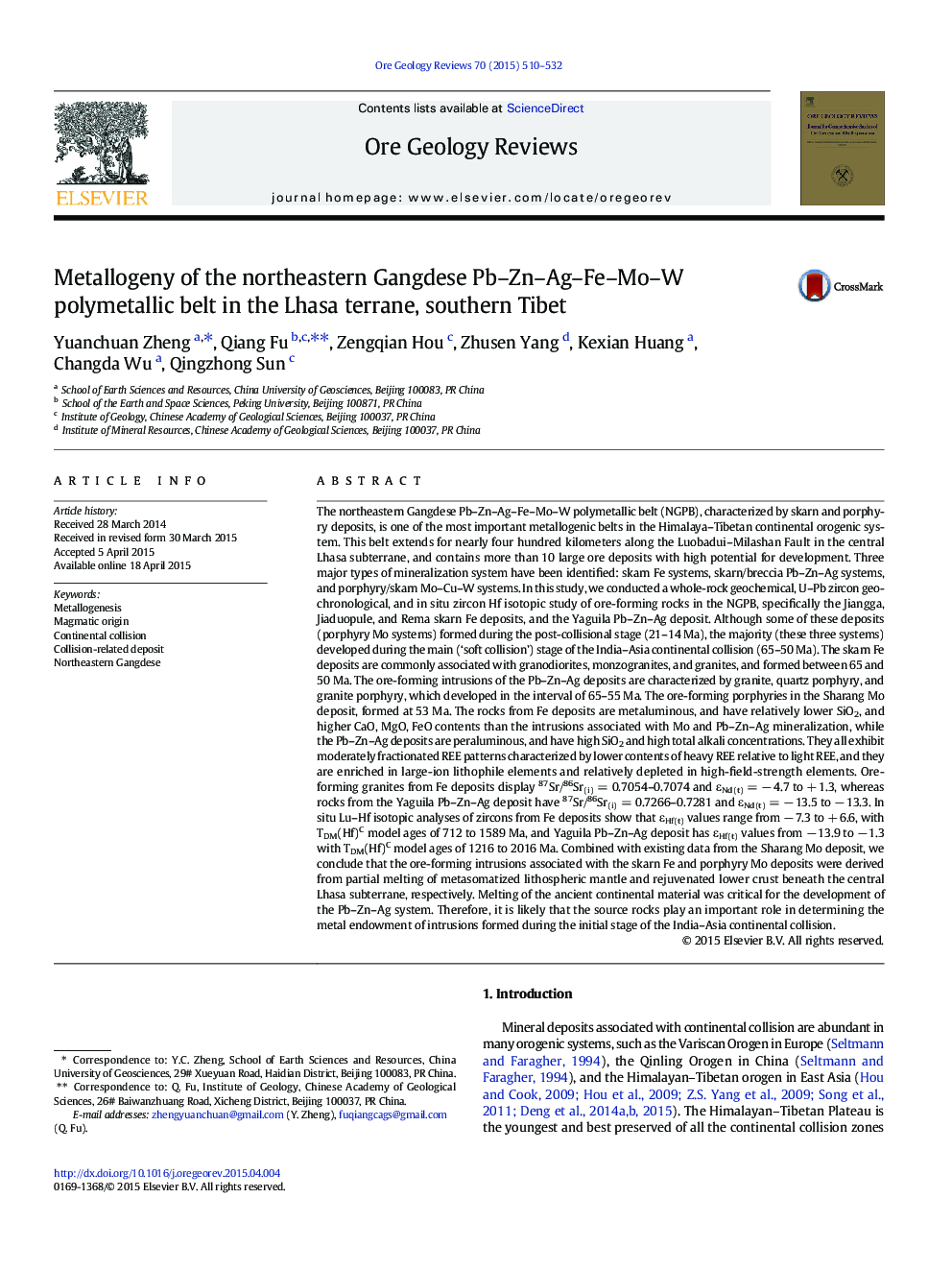| کد مقاله | کد نشریه | سال انتشار | مقاله انگلیسی | نسخه تمام متن |
|---|---|---|---|---|
| 4696993 | 1637234 | 2015 | 23 صفحه PDF | دانلود رایگان |

• Mineralization in the NGPB mainly formed during the main-stage of India-Asia collision.
• Skarn Fe deposits are genetically associated with mantle-derived felsic magmas.
• Intrusions related to Pb–Zn–Ag deposits are derived from partial melting of an ancient upper crust.
• Porphyries associated with Mo mineralization are derived from a rejuvenated lower crust.
• Development of the three types of deposits is induced by roll-back of the Neo-Tethyan ocean slab.
The northeastern Gangdese Pb–Zn–Ag–Fe–Mo–W polymetallic belt (NGPB), characterized by skarn and porphyry deposits, is one of the most important metallogenic belts in the Himalaya–Tibetan continental orogenic system. This belt extends for nearly four hundred kilometers along the Luobadui–Milashan Fault in the central Lhasa subterrane, and contains more than 10 large ore deposits with high potential for development. Three major types of mineralization system have been identified: skarn Fe systems, skarn/breccia Pb–Zn–Ag systems, and porphyry/skarn Mo–Cu–W systems. In this study, we conducted a whole-rock geochemical, U–Pb zircon geochronological, and in situ zircon Hf isotopic study of ore-forming rocks in the NGPB, specifically the Jiangga, Jiaduopule, and Rema skarn Fe deposits, and the Yaguila Pb–Zn–Ag deposit. Although some of these deposits (porphyry Mo systems) formed during the post-collisional stage (21–14 Ma), the majority (these three systems) developed during the main (‘soft collision’) stage of the India–Asia continental collision (65–50 Ma). The skarn Fe deposits are commonly associated with granodiorites, monzogranites, and granites, and formed between 65 and 50 Ma. The ore-forming intrusions of the Pb–Zn–Ag deposits are characterized by granite, quartz porphyry, and granite porphyry, which developed in the interval of 65–55 Ma. The ore-forming porphyries in the Sharang Mo deposit, formed at 53 Ma. The rocks from Fe deposits are metaluminous, and have relatively lower SiO2, and higher CaO, MgO, FeO contents than the intrusions associated with Mo and Pb–Zn–Ag mineralization, while the Pb–Zn–Ag deposits are peraluminous, and have high SiO2 and high total alkali concentrations. They all exhibit moderately fractionated REE patterns characterized by lower contents of heavy REE relative to light REE, and they are enriched in large-ion lithophile elements and relatively depleted in high-field-strength elements. Ore-forming granites from Fe deposits display 87Sr/86Sr(i) = 0.7054–0.7074 and εNd(t) = − 4.7 to + 1.3, whereas rocks from the Yaguila Pb–Zn–Ag deposit have 87Sr/86Sr(i) = 0.7266–0.7281 and εNd(t) = − 13.5 to − 13.3. In situ Lu–Hf isotopic analyses of zircons from Fe deposits show that εHf(t) values range from − 7.3 to + 6.6, with TDM(Hf)C model ages of 712 to 1589 Ma, and Yaguila Pb–Zn–Ag deposit has εHf(t) values from − 13.9 to − 1.3 with TDM(Hf)C model ages of 1216 to 2016 Ma. Combined with existing data from the Sharang Mo deposit, we conclude that the ore-forming intrusions associated with the skarn Fe and porphyry Mo deposits were derived from partial melting of metasomatized lithospheric mantle and rejuvenated lower crust beneath the central Lhasa subterrane, respectively. Melting of the ancient continental material was critical for the development of the Pb–Zn–Ag system. Therefore, it is likely that the source rocks play an important role in determining the metal endowment of intrusions formed during the initial stage of the India–Asia continental collision.
Proposed tectonic illustrations of the development of the skarn Fe, the granite-related Pb–Zn–Ag, and the porphyry Mo deposits in the northeastern Gangdese polymetallic belt induced by roll-back of the subducted Neo-Tethyan ocean slab during the main-stage of India–Asia continental collision (65–50 Ma). The skarn Fe deposits are genetically associated with mantle-derived magmas; the intrusions related to Pb–Zn–Ag and porphyry Mo deposits are derived from partial melting of a relatively ancient upper and a rejuvenated lower crust, respectively.Figure optionsDownload as PowerPoint slide
Journal: Ore Geology Reviews - Volume 70, October 2015, Pages 510–532